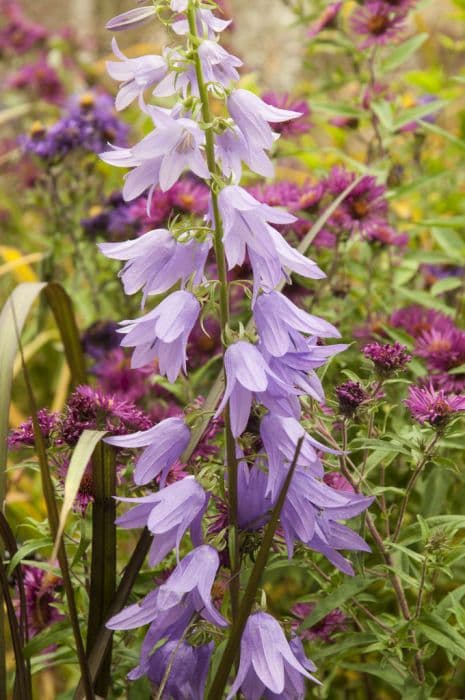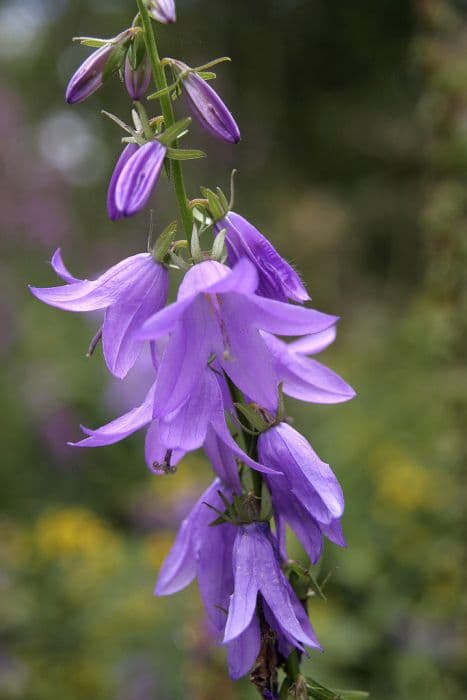Blue Throatwort Trachelium caeruleum

ABOUT
The common name of Trachelium caeruleum is Blue Throatwort. This plant is recognized for its dense clusters of small flowers that create a frothy appearance, typically found in shades of blue, purple, or sometimes white. The flowers are gathered in broad, flat-topped clusters at the ends of the stems, presenting a cloud-like façade. The leaves of Blue Throatwort are oblong to lance-shaped, with a dark green color that forms an attractive, bushy foliage as a backdrop for the delicate floral display. The stems are sturdy, allowing the flower clusters to stand upright and give the plant a graceful presence. Overall, Blue Throatwort offers a romantic and airy element to gardens, attracting butterflies with its charming blooms that last throughout the warm months.
About this plant
 Names
NamesFamily
Campanulaceae
Synonyms
Blue Throatwort, Blue Lace Flower, Throatwort
Common names
Campanula marchaliana, Campanula perdiguera, Campanula trachelium, Throatwort caerulea, Trachelium album, Trachelium angustifolium, Trachelium caeruleum, Trachelium lanceolatum, Trachelium ovatum, Trachelium paniculatum, Trachelium parviflorum, Trachelium umbellatum.
 Toxicity
ToxicityTo humans
Blue throatwort is not commonly known to be toxic to humans. However, it is always advisable to exercise caution and avoid ingesting plants that are not known to be edible. If a person were to ingest any part of the blue throatwort and experience symptoms such as nausea, vomiting, or diarrhea, they should seek medical attention. It's important to remember that even non-toxic plants can sometimes cause allergic reactions or be irritants to certain individuals, so it's best to avoid consuming plant material unless it is confirmed to be safe for human consumption.
To pets
Blue throatwort is not typically listed as a toxic plant to pets. Nonetheless, it's generally recommended that pets not be allowed to ingest plants, as they could potentially cause gastrointestinal upset or an allergic reaction. If your pet does consume any part of the blue throatwort and then exhibits symptoms such as vomiting, diarrhea, or unusual behavior, you should consult your veterinarian. Remember, not all plants that are safe for humans are safe for pets, and vice versa. Keeping an eye on your pets around houseplants and in the garden is always a good preventative measure.
 Characteristics
CharacteristicsLife cycle
Perennials
Foliage type
Evergreen
Color of leaves
Green
Flower color
Blue
Height
2-3 feet (60-90 cm)
Spread
1-2 feet (30-60 cm)
Plant type
Herb
Hardiness zones
7
Native area
Mediterranean
Benefits
 General Benefits
General Benefits- Aesthetic appeal - Trachelium caeruleum, commonly known as blue throatwort, boasts delicate clusters of small, vibrant flowers that add a splash of color to any garden or bouquet.
- Attracts pollinators - The flowers of the blue throatwort are known to attract bees, butterflies, and other beneficial pollinators to the garden, enhancing the pollination of plants and contributing to biodiversity.
- Drought tolerance - Once established, blue throatwort has moderate drought tolerance, making it suitable for xeriscaping and low-water gardens.
- Cut flower use - Blue throatwort is popularly used in cut flower arrangements as it provides long-lasting blooms and a unique texture that can complement a wide variety of other flowers.
- Varied landscaping uses - Blue throatwort is versatile for landscaping; it can be planted in borders, as part of a mass planting, or containers, providing flexibility in garden design.
 Medical Properties
Medical PropertiesThis plant is not used for medical purposes.
 Air-purifying Qualities
Air-purifying QualitiesThis plant is not specifically known for air purifying qualities.
 Other Uses
Other Uses- Blue throatwort can be used as a natural fabric dye, providing a range of blue and purple hues to textiles.
- In horticultural therapy, the cultivation of blue throatwort is sometimes used as an activity to improve mental well-being and physical health through gardening.
- As a teaching tool in botany education, blue throatwort can be used to illustrate plant anatomy and the process of pollination due to its distinct flower structure.
- Blue throatwort is utilized in landscape designing to create 'moon gardens', where its vivid blue flowers stand out in the moonlight, providing a unique nocturnal aesthetic.
- The long-lasting flowers of blue throatwort make them ideal for use in dried floral arrangements, maintaining their shape and color well after drying.
- Its blooms are often used in crafting, where the flower heads can be incorporated into handmade paper or pressed flower artwork.
- In eco-friendly burial practices, blue throatwort is sometimes planted on graves as a natural and biodiverse alternative to cut flowers.
- Gardeners may use blue throatwort as a natural indicator plant, as its thriving or wilting can signal underlying soil or water conditions in the garden.
- Blue throatwort has been used in some cultures as part of ceremonial garlands or decorations for events and rituals, symbolizing remembrance or respect.
- These flowers are sometimes included in photography and painting workshops to teach composition and color theory due to their vibrant and rich color.
Interesting Facts
 Feng Shui
Feng ShuiThe Blue Throatwort is not used in Feng Shui practice.
 Zodiac Sign Compitability
Zodiac Sign CompitabilityThe Blue Throatwort is not used in astrology practice.
 Plant Symbolism
Plant Symbolism- Forgotten Beauty: Trachelium caeruleum, commonly known as blue throatwort, is not as widely recognized as other garden flowers, thus it often symbolizes hidden or forgotten beauty.
- Longevity: With its long-lasting flowers, blue throatwort represents enduring life and persistence.
- Peace: The soothing blue hues of the flower are often associated with calmness and peace.
- Elegance: Blue throatwort has a refined appearance and thus can symbolize elegance and grace.
 Water
WaterThe Trachelium caeruleum, commonly known as Blue Throatwort, requires consistent moisture, so it should be watered thoroughly when the top inch of soil feels dry. Generally, this may be once or twice a week, but frequency should be adjusted according to weather conditions and soil drainage. Use room temperature water and aim for an even watering using a watering can or hose attachment that simulates rainfall, ensuring the root zone is reached without waterlogging the soil. For potted specimens, ensure they are watered until excess water drains out of the pot’s bottom. As a guideline, during active growth, Blue Throatwort may require approximately 1 gallon of water per week, depending on the size of the plant and environmental conditions.
 Light
LightBlue Throatwort thrives best in full sun to partial shade conditions. It prefers a location where it can receive at least 4 to 6 hours of direct sunlight daily, which promotes the best growth and flowering. However, in extremely hot climates, some afternoon shade can prevent scorching and provide protection during the hottest part of the day. An east-facing or west-facing spot would be ideal, where the plant can enjoy bright morning or late afternoon light.
 Temperature
TemperatureBlue Throatwort prefers moderate temperature conditions and can tolerate a range from about 50°F to 75°F comfortably. While it can survive brief periods of cooler temperatures down to about 40°F, hard frosts and freezing conditions should be avoided. During the growing season, maintaining an environment within its preferred temperature range will help ensure healthy growth.
 Pruning
PruningPruning Blue Throatwort typically involves deadheading spent flowers to encourage further blooming and to maintain a tidy appearance. This can be done throughout the flowering season as needed. Additionally, cutting back the plant by a third after the main flowering flush can stimulate a second round of blooms. The best time for heavy pruning is in late winter or early spring before new growth begins.
 Cleaning
CleaningAs needed
 Soil
SoilBlue throatwort thrives in well-draining, loamy soil with a pH range of 6.0-7.0. A mix with equal parts garden soil, peat, and perlite or sand is ideal. Ensure it has good organic content but doesn't retain excessive water.
 Repotting
RepottingBlue throatwort should be repotted every 2-3 years to refresh the soil and accommodate root growth. It's best to repot in the spring before the new growth starts.
 Humidity & Misting
Humidity & MistingBlue throatwort prefers moderate to high humidity levels; aim for a range of 40-70%. Avoid placing it in excessively dry environments, which can cause stress to the plant.
 Suitable locations
Suitable locationsIndoor
Place Blue throatwort in a bright spot with indirect sun and keep soil moist.
Outdoor
Plant Blue throatwort in partial shade, in well-draining soil.
Hardiness zone
7-11 USDA
 Life cycle
Life cycleBlue throatwort (Trachelium caeruleum) typically starts its life cycle as a seed, which will germinate when exposed to the right conditions of warmth and moisture, usually in spring or early summer. Once germinated, the seedling emerges, developing its root system and initial leaves, entering the vegetative growth stage where it focuses on collecting sunlight and nutrients to grow. As the plant matures, it develops a robust stem and a foliage of dense green leaves, usually within a few weeks to months depending on the environment. When the plant reaches maturity, typically in late spring to summer, it produces clusters of small, funnel-shaped flowers in shades of blue, purple, or white. After pollination, these flowers will produce seeds, which can be dispersed by wind or wildlife to propagate new plants. As an herbaceous perennial, blue throatwort may die back to the ground after flowering in cooler climates or remain evergreen in milder ones, only to re-sprout from the base the following season, completing its life cycle.
 Propogation
PropogationPropogation time
Spring-Early Summer
For the Blue Throatwort (Trachelium caeruleum), the most popular method of propagation is through seeds. The best time to sow seeds is in late winter or early spring when temperatures start to rise consistently but frost danger has passed. To propagate, spread the small seeds thinly across the surface of a well-drained seed starting mix in a tray and gently press them into the soil, as they need light to germinate. Cover the tray with plastic wrap or a propagator lid to maintain humidity and keep it in a warm place with indirect light. Seedlings usually emerge in 14 to 28 days. Once seedlings are large enough to handle, they can be transplanted into individual pots and later moved outdoors after the last frost.









